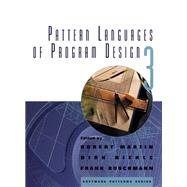
Robert C. Martin has been a software professional since 1970 and an international software consultant since 1990. He is founder and president of Object Mentor, Inc., a team of experienced consultants who mentor their clients in the fields of C++, Java, OO, Patterns, UML, Agile Methodologies, and Extreme Programming.
Dirk Riehle is a software engineer at Ubilab. He is involved in the Geo project, which is setting up a reflective distributed object-oriented software architecture.
Frank Buschmann is a software engineer at Siemens, where he focuses on object-oriented technology, software reuse, and patterns. He is a member of the ANSI C++ standards committee.
| Introduction: Hybrid Vigor and Footprints in the Snow | ix | (6) | |||
| Preface | xv | ||||
| Part 1 General Purpose Design Patterns | 1 | (88) | |||
|
5 | (14) | |||
|
|||||
|
19 | (10) | |||
|
|||||
|
29 | (18) | |||
|
|||||
|
|||||
|
47 | (20) | |||
|
|||||
|
|||||
|
67 | (12) | |||
|
|||||
|
79 | (10) | |||
|
|||||
| Part 2 Variations on Design Patterns | 89 | (54) | |||
|
93 | (12) | |||
|
|||||
|
105 | (20) | |||
|
|||||
|
125 | (18) | |||
|
|||||
|
|||||
| Part 3 Architectural Patterns | 143 | (44) | |||
|
147 | (16) | |||
|
|||||
|
163 | (24) | |||
|
|||||
| Part 4 Distribution Patterns | 187 | (104) | |||
|
191 | (40) | |||
|
|||||
|
231 | (14) | |||
|
|||||
|
|||||
|
245 | (16) | |||
|
|||||
|
|||||
|
|||||
|
261 | (16) | |||
|
|||||
|
|||||
|
|||||
|
277 | (14) | |||
|
|||||
| Part 5 Persistence Patterns | 291 | (54) | |||
|
293 | (20) | |||
|
|||||
|
|||||
|
|||||
|
|||||
|
|||||
|
313 | (32) | |||
|
|||||
|
|||||
| Part 6 User Interface Patterns | 345 | (14) | |||
|
347 | (12) | |||
|
|||||
|
|||||
| Part 7 Programming Patterns | 359 | (32) | |||
|
363 | (14) | |||
|
|||||
|
|||||
|
377 | (14) | |||
|
|||||
|
|||||
|
|||||
| Part 8 Domain-Specific Patterns | 391 | (56) | |||
|
395 | (14) | |||
|
|||||
|
409 | (22) | |||
|
|||||
|
|||||
|
431 | (16) | |||
|
|||||
|
|||||
| Part 9 Process Patterns | 447 | (80) | |||
|
451 | (20) | |||
|
|||||
|
|||||
|
471 | (16) | |||
|
|||||
|
|||||
|
487 | (16) | |||
|
|||||
|
503 | (24) | |||
|
|||||
|
|||||
| Part 10 Patterns on Patterns | 527 | (48) | |||
|
529 | (46) | |||
|
|||||
|
|||||
| About the Authors | 575 | (10) | |||
| Index | 585 |
The New copy of this book will include any supplemental materials advertised. Please check the title of the book to determine if it should include any access cards, study guides, lab manuals, CDs, etc.
The Used, Rental and eBook copies of this book are not guaranteed to include any supplemental materials. Typically, only the book itself is included. This is true even if the title states it includes any access cards, study guides, lab manuals, CDs, etc.